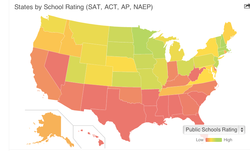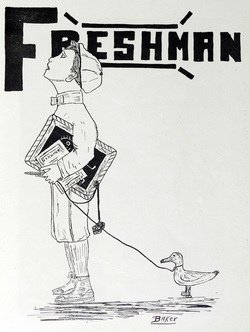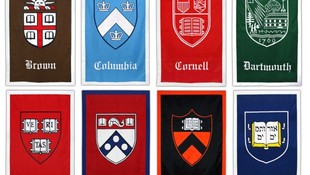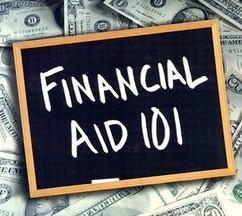|
We clued you in to the colleges where you're most likely to get an STD but you really need to know another great big piece of the STD puzzle. Colleges are located in States. And some States/Regions have a higher incidence of those nasty STDs than others. Check out the heat maps below to see how your state fares.
0 Comments
 Have you ever wondered if your public school system will do a good job of educating your children? Elite colleges consider your application state when they're building their class list, but have you ever considered what an education in your state means to outsiders? We found the coolest app that will give you just that information! Business Insider compiled the data and put it on an easy to read map so that you can get a quick glimpse of how your public school system is faring. As you peruse the map, keep a few caveats in mind.
 You’re glumly watching your Facebook and Twitter as friend after friend exclaims, “I got into the law school of my choice!” And you wish some of that luck would rub off on you. So far, no deal. Rejection is hard to take. It’s even harder when it feels like you’re the only one that didn’t get the fat envelope from your favorite law school. The big question is; where do you go from here? First off, let’s debunk the biggest myth. Everyone did not get into their favorite law school. Well, unless you count for readjusted expectations. Research shows that, once your hypothetical choices (in love, life, and law school) have been eliminated and you are left with only concrete options, the option you pick will become your “favorite” and you will actually be quite happy with it. This holds true even if one of the previously withheld options suddenly becomes available. How does this work? Say you applied to Yale (#1), UC-Berkeley (#9), George Washington (#21), Georgia State (#54), Brooklyn Law School (#80), Gonzaga (#113), University of Maine #134), and University of San Francisco (#144). When decisions start rolling out, you get declines from Yale, UC-Berkeley, George Washington, Georgia State, and Gonzaga. You get wait-listed by Brooklyn Law and University of Maine. Only the University of San Francisco gives you the green light and invites you to summer orientation. At first, you're in denial: "No! I can't have only gotten into one law school. I just don't believe this!" This quickly turns to anger: "I can't believe I wasted all of that time, energy, and worry into a bunch a schools that didn't even want me!" You secretly know that you didn't have a very good chance of getting into some of the top law schools, given your grades and LSAT score. But, come on! Only one school really said yes? As you move into the bargaining stage of your grief you quickly take action to shore up possibilities with your wait-list schools. You update your transcripts, write a few letters, and collect some additional letters of recommendation to send to them; hoping something will change (although doubting it will). Nothing changes over the next few weeks and the silence from your wait-list schools is deafening as you slip into a slight depression. Ugh. The University of San Francisco. Hold on! What is so wrong with the University of San Francisco. They were smart enough to scoop you up, weren't they? You revisit their stats. Yes, it is the lowest ranked law school but look at all of the schools that are unranked or unpublished beneath them. There are a ton! And it is in San Francisco. How rough can it be to spend 3 years in the sun with surfing only a few miles away? You peruse the web site and realize they aren't very bad at all. In fact, Justice Scalia is stopping by USF on his book tour next month. It can't be too bad of a school if Justice Scalia is willing to stop by. The bar pass rate for first timers is 75% - which isn't perfect - but the current pass rate for all California test takers is just a breath over 50% so USF seems to be doing something right. The employment rates aren't stellar but that seems to be the case everywhere. Hey! USF is well known for educating lawyers who fight for social justice and that is exactly what you planned to study! And, my friend, you have nicely moved into the rebound phase of your journey to law school. Guess which school is your favorite? The one that chose you! You will pack up your belongings, head to law school at your favorite school, and scoff at the poor fools who are toiling away in the frigid northeast while you study, sun, and surf in California. Not a bad life and at the end of the day; everyone who graduates is an attorney so the University of San Francisco is a fabulous school for you! But wait (list)! Remember those schools where you’re wait-listed? Let’s say the University of Maine contacts you after you’ve made your deposit at USF. They tell you they now have room for you in their upcoming class and invite you to change your mind. Chances are, you’ll elect to forego your opportunity to pull up to a better-ranked school. You’ve become quite content with the notion of being a surfing law student in sunny California and you’ve already worked through the Five Stages of Rejection and eliminated your desire to attend the law schools that spurned you. Your choice may have been very different had both schools accepted you from the beginning. Hence, you were indeed accepted to your (now) favorite law school! Choice is a funny thing. So when you make your own announcement regarding your law school acceptance, you can honestly say your acceptance is from your favorite law school!  Everybody seems to be headed to college five minutes after high school graduation celebrations are complete. You spend the summer collecting and packing the items you’ll need to survive dorm life (like toilet paper) as well as a few items just for fun. Anticipation builds as the big day arrives and you enter your college ready to make new friends, attend classes, and work toward making your career dreams and aspirations come true. How is it that, given 12 years of preparation and a summer of celebration and packing, only 56% of you manage to graduate within a six year timeframe? Becoming a college graduate (i.e., earning your Bachelor’s degree) takes time, money, preparation, and support. However the college you attend is a very important, yet overlooked, factor that can help lead you to success. This is one major reason that U.S. News goes to the trouble of producing college rankings each year. It’s not really about attending the best college in the nation as it is attending the college that best fits your academic needs. Public Universities With the Worst Graduation Rates School State Graduation Rate Southern University at New Orleans Louisiana 4.0% University of the District of Columbia D.C. 7.7% Kent State – East Liverpool Ohio 8.9% Rogers State University Oklahoma 11.5% Texas Southern University Texas 13.3% Ohio University Southern Campus Ohio 13.7% Kent State University Ohio 13.9% Purdue University North Central Illinois 14.0% Cameron University Oklahoma 14.1% For-Profit schools are notorious for taking your money but leaving you with few skills and no degree in the end. However, people rarely talk about the public universities that are providing a similar disservice. Why is it that these public universities have failure rates as high (or higher) than many of the for-profit schools? Consider the factors required to successfully graduate:
By: Sherry Thompson  One piece of advice passed around to students who are selecting their college or university is to find out whether the freshmen are happy. Good advice. The goal of every parent and student is to have that student be happy while attending school. Happiness can be defined in myriad ways and trying to turn an emotion (or even an attitude) into a quantifiable piece of data isn't easy. But this is a question worth pursuing. So how does one go about ascertaining the joy of freshmen at any University? You could: Ask the school how many students are unhappy with the quality of their coursework and the campus life. Wrong. No self-respecting school is going to answer no to either of these questions if they want you on their campus next year. Ask the students when you go to Campus Visits. Remember what they taught you regarding a truncated sample in statistics? The Days on Campus guides have been hand-picked to interact with you. Coincidentally, those are exactly the students you will have access to when you visit the campus. Hence, you will have some positive bias in your sampling. Unless you already know students attending the school, you probably aren’t going to learn much using this technique. Ask Google. Google the schools you are considering. Check for reports of suicides, protests/riots, and rapes. If you are seeing a lot of unrest (like the current protests at Dartmouth), you are probably not looking at happy freshmen. Check out College Prowler, a website that has a student from each school write a short description of the school. If this student representative says anything close to “this is where fun goes to die”, you can assume the freshmen are unhappy. Ask the U.S. Department of Education. According to them, they have solved the mystery of freshman happiness using statistics and by defining the term happiness as willing to return for a second year of abuse. Are you happy? Well, let’s check their list and see who is the happiest. To shake things up a bit, these guys have created a list for Private Colleges and Universities as well as State Colleges and Universities. But they can’t fool us – we took the percentages they provided and compiled a list of the happiest Private and Public Colleges and Universities just for you. We’re providing the top 25 because, well, to be honest, the private university students are much happier than the public university students based on their results. U. S. Colleges With Highest Freshmen Retention Rates 1. Princeton University 99.2% 2. Harvey Mudd College 99% 3. Yale University 99% 4. University of Pennsylvania 98.3% 5. University of Chicago 98.1% 6. Harvard University 98.1% 7. College of the Holy Cross 98.1% 8. Stanford University 98.1% 9. Carleton College 98.15 10. University of Notre Dame 98% 11. Wesleyan University 97.9% 12. California Institute of Technology 97.5% 13. Brown University 97.5% 14. Massachusetts Institute of Technology 97.3% 15. Columbia University 97.2% 16. Duke University 97.2% 17. Pomona College 97.2% 18. Williams College 97.1% 19. Tufts University 97% 20. University of Southern California 97% 21. UCLA 96.9% 22. Berkeley 96.8% 23. Vanderbilt University 96.6% 24. U.S. Naval Academy 96.5% 25. Washington University St. Louis 96.5% Here is my take on their study. Hahahahaha. I'm pretty sure they think the world is incapable of recognizing a bad study when they see it. Do they not think freshman retention has more to do with whether you snagged a place in an elite school? Check out the US News and World Report's Top Public Colleges and compare them to the full list of the happiest public colleges as defined by freshman retention rates to see the similarities. Could weather impact retention? If you review the happiest public colleges and universities a ton of them are located in states with warm climates. Do they not realize their operationalized definition means all Utah schools must be unhappy because their Mormon students go to school briefly and then leave some time during the freshmen year to be missionaries for their church? Did no one think to maybe survey the freshmen and ask if they’re happy? This could easily be done when other data collection activities are happening. Every year organizations collect data on sexual activity, drug use, etc. A couple of questions targeted to ascertain freshman happiness could easily be tucked in one of those. Yes, it might be more expensive. But they might also get an truer idea of where freshmen are happy. I asked a student or two who attend school at at least one of listed happy institutions to confirm or deny that they would be one of the schools with the happiest freshman. The responses failed to confirm delight and joy. Perhaps this is because it’s finals time or perhaps this is because the Department of Education’s assumption is beyond ridiculous. I’ll let you decide that. (Short answer would probably be read Campus Prowler.) By: Sherry Thompson  Do you have your heart set on attending an Ivy League university? Going to an Ivy League school adds cache’ to your resume’ and provides you with a stellar education. However, the sticker price for attending these schools is high. If you’re a good student with a high g.p.a. and high SAT scores, don’t let that sticker price scare you away just yet. The Ivy Leagues know their prices are out of reach for many families and often dip into their hefty endowments to allow you to attend their schools at an affordable price – if you can get accepted. Compare the average debt of a student graduating from an Ivy League to that of a student graduating from a state college and you’ll see that it’s often more expensive, debt-wise, to attend the state school. University % Accepted # Applied 3 year trend Avg Debt Harvard 5.79% 35,023 trending up $10,102 Yale 6.72% 29,610 trending up $9,254 Columbia 6.89% 33,531 trending flat $18,420 Princeton 7.29% 26,498 trending flat $5,330 Brown 9.16% 28,919 trending down $20,455 Dartmouth 10.05% 22,416 trending flat $16,615 University of Pennsylvania 12.10% 31,280 trending flat $17,891 Cornell 15.15% 40,006 trending up $19,180 Do you have your heart set on attending an Ivy League university? Going to an Ivy League school adds cache’ to your resume’ and provides you with a stellar education. However, the sticker price for attending these schools is high. If you’re a good student with a high g.p.a. and high SAT scores, don’t let that sticker price scare you away just yet. The Ivy Leagues know their prices are out of reach for many families and often dip into their hefty endowments to allow you to attend their schools at an affordable price – if you can get accepted. Compare the average debt of a student graduating from an Ivy League to that of a student graduating from a state college and you’ll see that it’s often more expensive, debt-wise, to attend the state school. In addition to providing you with the average debt of a graduating student, we thought you might be interested in acceptance rates and application trends for our beloved Ivys. So here is our casual analysis.
Hopefully this information will help you make some good decisions regarding the ivy schools to which you choose to apply. If you want to see the New York Times' application information for more schools, you know what to do. by: Sherry Thompson  Financial aid is the vehicle many students use to finance their college educations. There are many forms of it which can make it confusing. In truth the better you understand your financial aid package, the better you will be able to make good decisions about funding your education. The first step is to complete the FAFSA, any college financial aid forms, and possibly the PROFILE application. Without your application materials, your school will not be able to provide you with the best financial aid package available. Apply early to obtain the best financial aid package. When you receive the letter detailing what your college can offer you, knowing a bit about each component of your package will help you make the best decisions. Remember, grants and scholarships don’t have to be paid back. Subsidized loans are less expensive to pay back and Unsubsidized loans are the most expensive to pay back. Here are some details about the most common forms of financial aid offered:
As you can see, there are a lot of options available to help you meet your educational expenses. It is always better if you can avoid taking loans but with the cost of education, that is not always an option. Remember to capitalize on CLEP tests, credits for A.P. tests, and early college options to help allay some of the expenses.  May 1st is officially known as May Day. This day is a celebration of Spring when children exchange baskets of flowers and dance around the maypole in a Pagan-gone-Christian holiday. And yet May Day is also referenced as a call of distress – an urgent request for help. Which leads us to the distress potential students are experiencing as they try to choose the perfect school before the May 1st deadline. How do you find the college that will be your perfect home for the next four years? How do you identify the college that will be a perfect fit for you? One item on your agenda is most likely affordability. You can’t simply look at the sticker price of each of the colleges; this can be deceiving. You need to calculate the cost of attending the college in your specific case. Be sure you've complete your FAFSA so you will have a complete financial aid picture. Will your AP test scores allow you to attend for a shorter time, thereby lessening the cost of your undergraduate education? How much will it cost to attend each school each year? Will the return on a higher price tag result in better prospective job opportunities? These are important questions. However, money isn’t everything. College quality is ranked by U.S. News and World Report for quality and difficulty getting accepted this can provide some guidance but it isn't a blanket answer for everyone. Hopefully you’ve planned to visit the campus and sit in on a class to see if the school would be a good fit for you socially. Some schools have a heavy religious influence while others may have a social activist bent. Additionally, some schools excel in graduating fabulous social workers while others are notable for graduating future Nobel Prize winners in the sciences. Look at the majors offered by each school and use that plus your campus visit to help determine if the school is right for you. Also, check out College Prowler for a review of the campus by current students. One cautious student was determined to go to NYU and was excited to be accepted! When she visited the campus she was chagrined to realize the campus was too open and too busy for her tastes. Fortunately, she was also accepted to Vassar. Her visit there revealed a relatively closed campus which felt somehow safer to her. Despite her love for NYU and her desire to live in the city, she chose to attend Vassar. In retrospect she believes this was the best answer for her. Another factor is distance from home. This factor will determine how often you see your family and friends. It will also speak to whether you need to reserve more money in order to live in dorms or an apartment. Living away from family can be a good thing – living too far away from family may be great or not so great depending on your relationship with your family. Living too close to home may influence you to live at home. This can be a great way to save money but living at home may interfere with your ability have an actual college experience (e.g., join clubs, attend activities outside of class time, hang out in the library, etc.) No one can really make the right college choice for you but you. It takes careful research, considerable calculation and balancing, and a realistic look at your finances and your relationship with your family. Consider all of these factors and you’ll be sure to choose the college that’s exactly right for you. And as you slip your deposit into the mail, you can be confident that May Day will be a year of celebrating new beginnings. Now that you've successfully chosen a college that chose you, it’s time to concentrate on the hard stuff. For most of us, that means figuring out how to afford school. Fortunately, most financial aid offices are staffed with knowledgeable, friendly people who are excited to help you make your dreams come true. In order for them to succeed in helping you succeed, you need to make sure you take a few important actions.
When you complete the FAFSA, you will be asked to provide income information for your parents (if you are still considered a dependent). If your parents are no longer married, you are only asked to provide income information for the parent with whom you live most of the time. Also, be sure you are on the correct website. Some unscrupulous people will try to convince you to pay for making this application if you are unlucky enough to land on their website. Submitting the FAFSA is free! When you complete the PROFILE application, you are required to provide income information for both of your parents regardless of their marital status or living arrangements. It is assumed that both parents will be responsible to aid you in your educational endeavors. If your parents are no longer together, you will complete the PROFILE application with one parent and a separate web session will be available for your other parent to complete. This ensures both parents’ private information remains private. In rare instances, special circumstances would allow you to submit the income information for only one parent. If you feel you may be the exception, contact your college’s financial aid office; they are happy to work with you to see if you would qualify for this exception. Again, complete your financial aid applications as quickly as possible because once a college has awarded all of its funds, there is nothing that can be done for subsequent applicants. by: Sherry Thompson  The applications have been in for over a month and those college acceptance letters should start showing up in the next few weeks. Woot woot! The tough part will be deciding where to attend. How in the world do you make the right decision? There are three factors to consider when choosing the right school for you. Considering your Advanced Placement (AB) and International Baccalaureate (IB) test scores, personal funding situation, and fit will help you make the right decision. You have boat loads of high Advance /IB test scores and want to complete your undergrad degree as quickly as possible? Good job! Now take a closer look at those state school acceptance letters. Ivy Leagues and other highly selective schools are typically more reluctant to accept your test scores in place of actual classroom time. State schools will often accept scores of 3 or higher in lieu of classroom time – meaning you enter college as a Sophomore or Junior and save a bunch of tuition. You may be able to head to graduate school after only 2 years of undergrad – which can be a plus if you want to get your schooling completed as quickly (and as inexpensively) as possible. Not in a hurry? Those high AP/IB scores were probably key to your getting accepted to some of your higher ranking schools. If you are in no particular hurry to complete that undergrad degree, consider these schools. The key factor to consider here is money (a.k.a. debt) vs. prestige. Complete your FAFSA and your Profile applications early so that you can request your financial aid package from each school to determine which school will give you the best education for the least amount of money. (Warning: do not count loans as free money. Consider your tuition after grants and scholarships but leave the loans. This way you know exactly how much tuition you will be paying.) Another important factor is fit. How do you fit with the campus culture? Wrong for you = four very long years. A lot of schools will hold College Campus Visits so you can get a feel for the schools and decide if you really fit in. If they offer an overnight session; go! You'll have the opportunity to meet your potential peers (and suitemates). It’s surprising how many times a first choice college doesn’t get chosen once you have really checked out the campus and students. Regardless of which college you choose, congratulations on all of those acceptance letters! |
Categories
All
Archives
May 2015
Subscribe!Subscribe now so you don't miss a thing! |



 RSS Feed
RSS Feed